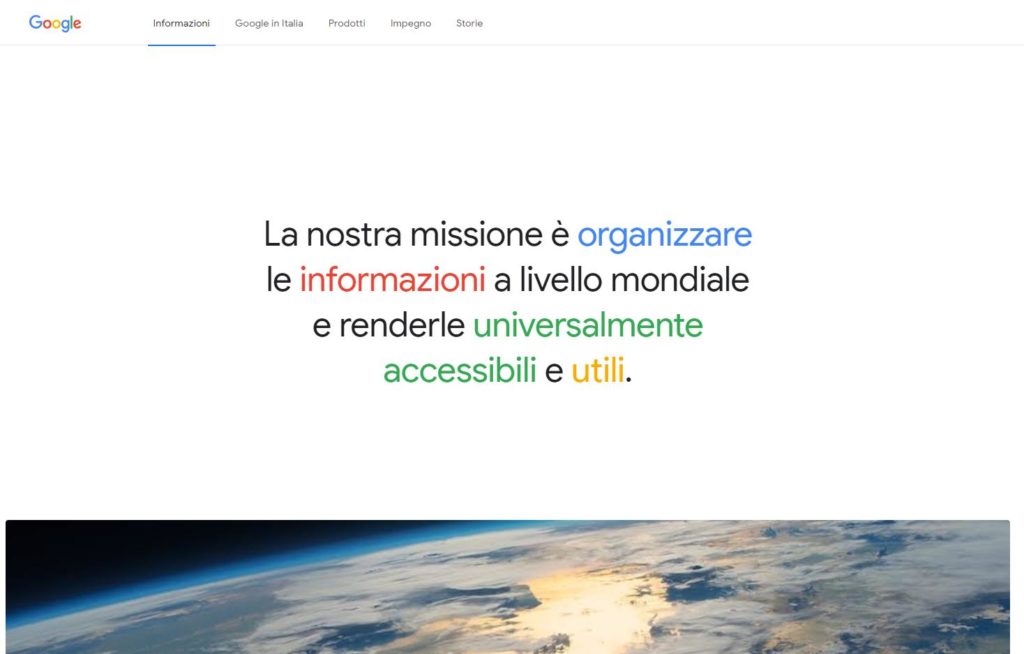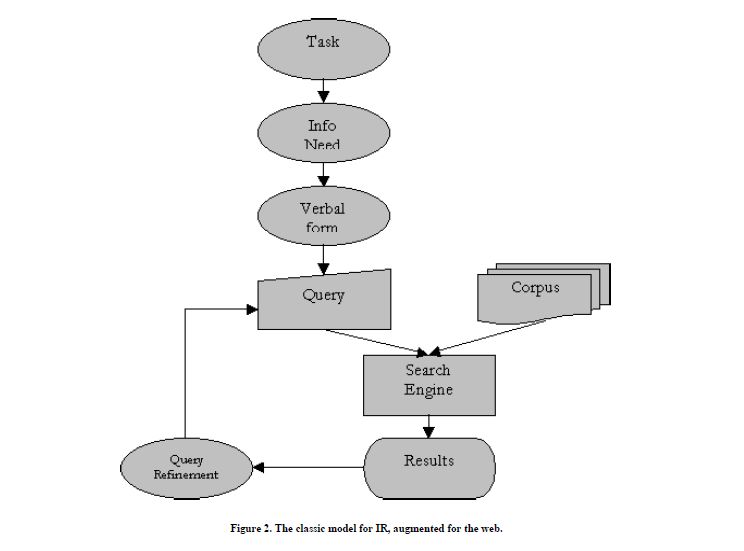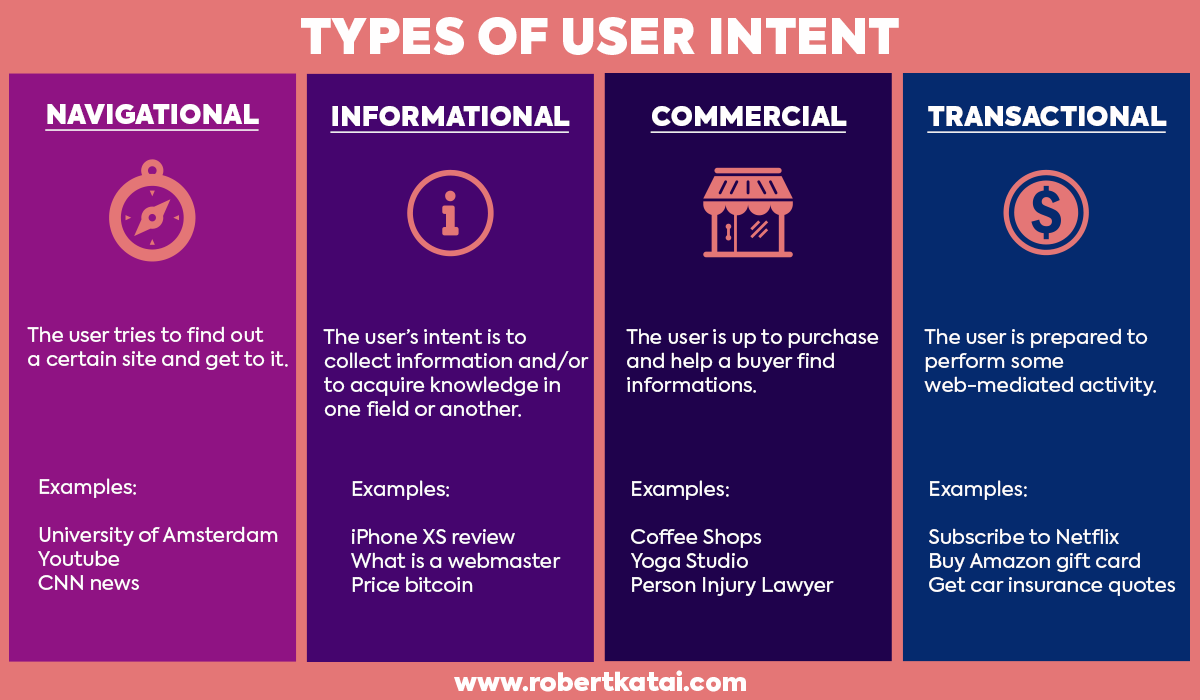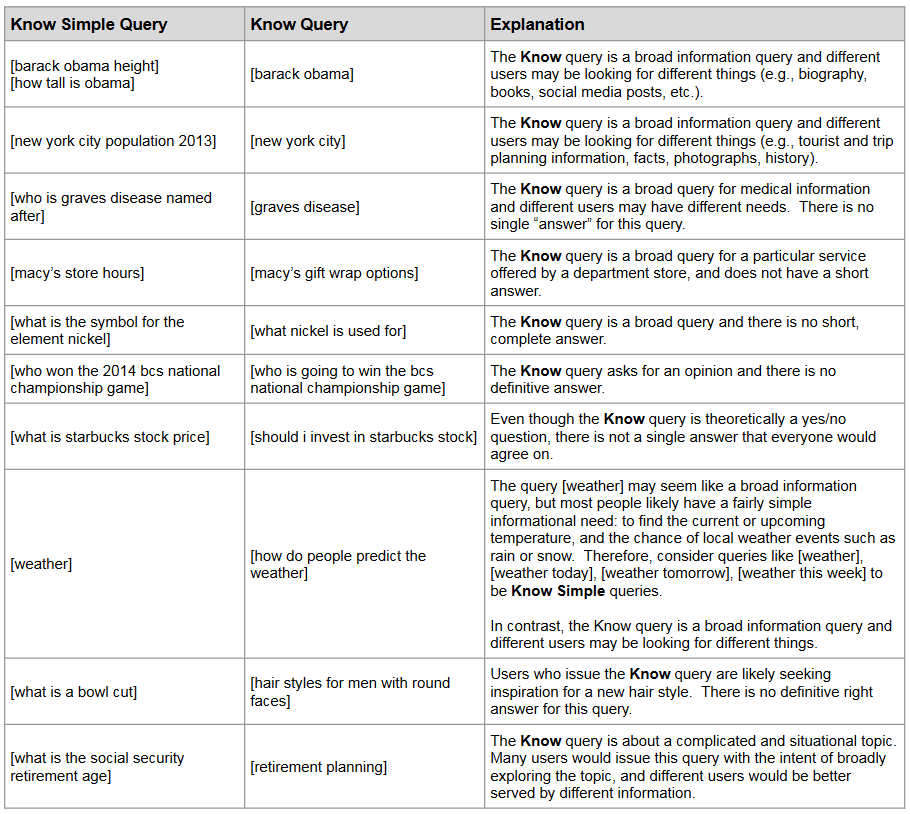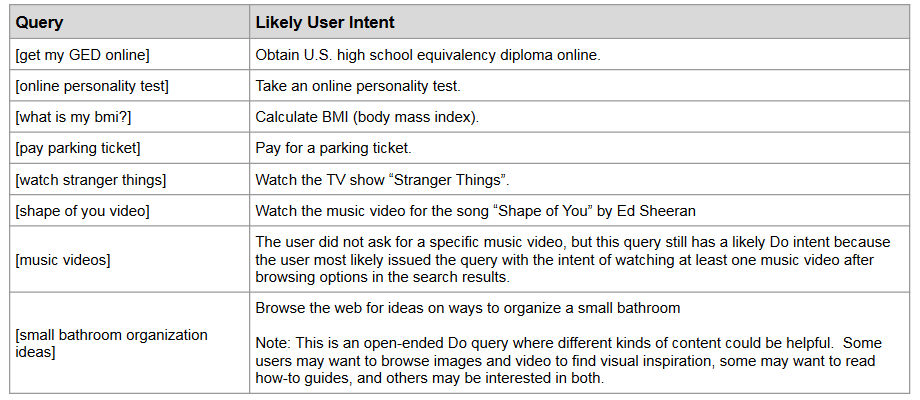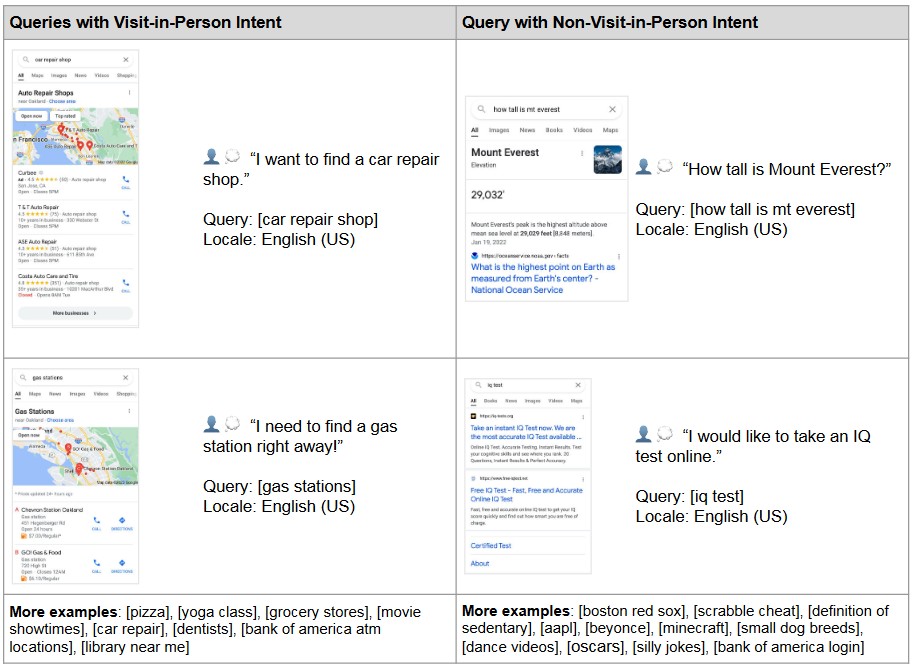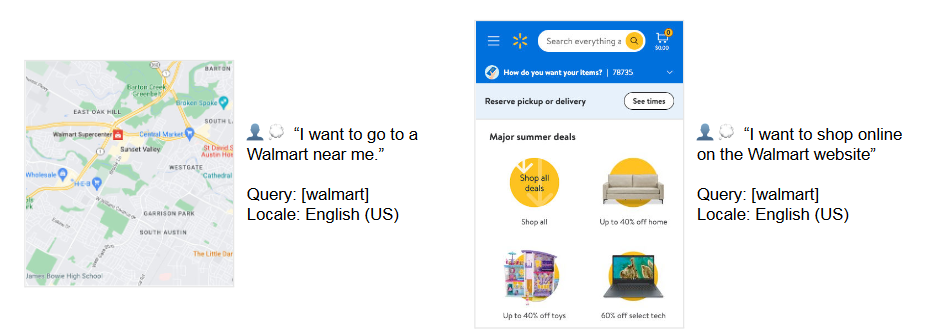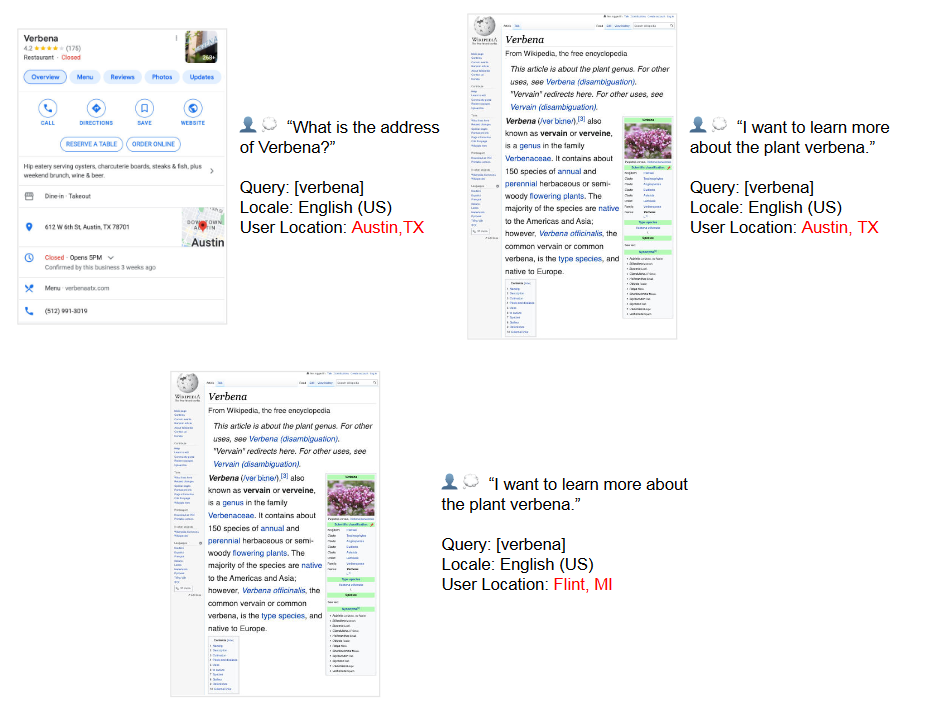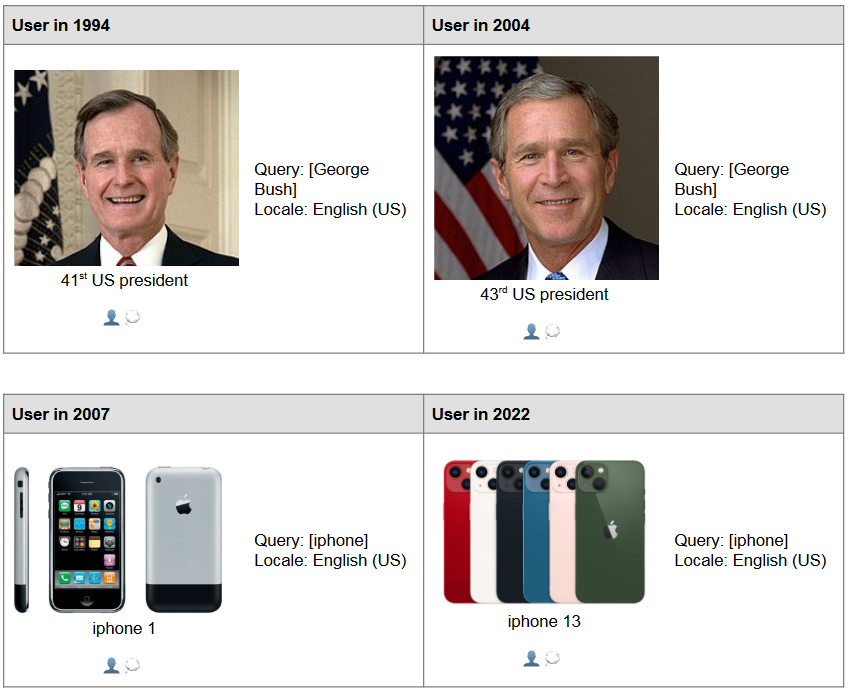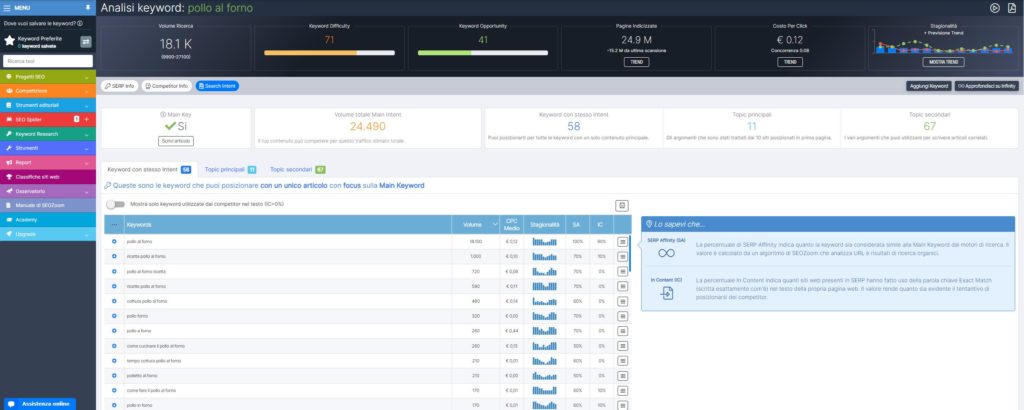Capire il search intent per migliorare il ranking
Nei discorsi sulla SEO ricorre spesso l’espressione search intent, una delle chiavi fondamentali per coinvolgere gli utenti e compiacere i motori di ricerca, ma da quasi 20 anni (da quando cioè l’espressione è stata coniata la prima volta) ci si limita di solito a citare le categorie Informational, Transactional, Navigational o Commercial. Eppure, il concetto non può essere ridotto a questa semplice classificazione, che non offre nessuna informazione pratica e utile a chi vuole sapere come realizzare un contenuto che abbia opportunità di posizionarsi, e solo comprendendo il vero significato di search intent e imparando a costruire i contenuti intorno a ciò che serve davvero agli utenti possiamo effettivamente migliorare il ranking delle nostre pagine su Google.
Che cos’è il search intent
Traducendo letteralmente dall’inglese, con l’espressione search intent facciamo riferimento a “intento di ricerca” o “intenzione di ricerca“, cioè ciò che sta dietro a ogni ricerca su Google o su un qualsiasi altro motore di ricerca.
Quando utilizzano un motore di ricerca, infatti, le persone hanno in mente qualcosa di specifico – le risposte ai loro problemi, informazioni sui servizi disponibili, offerte o recensioni sul prodotto a cui sono interessati e così via – e il search intent, chiamato anche user intent o audience intent, rappresenta proprio la spiegazione del motivo per cui un utente ha eseguito una ricerca online utilizzando quella query.
In altre parole, è l’esigenza primaria che ha spinto una persona a utilizzare Google e fare una ricerca, è come una scintilla, il punto di partenza dell’esperienza di ricerca e del search journey, e racchiude anche ciò che la persona si aspetta di trovare nelle pagine dei risultati. In pratica, quindi, il search intent ci dà un’idea dei “perché” dietro una query di ricerca – perché il nostro pubblico ne ha bisogno, perché è prezioso e perché qualcuno lo sta cercando, ma anche perché dobbiamo costruire quel contenuto (e in quel modo).
Search Intent SEO, un’analisi fondamentale
Possiamo dire, semplificando, che tutte le ricerche online sono mirate a soddisfare un bisogno reale, che può essere legato alla necessità di trovare informazioni su attualità o su un topic specifico, richiedere servizi, acquistare prodotti, o semplicemente visualizzare un preciso sito web.
Comprendere e intercettare il bisogno che muove l’azione e l’interesse delle persone online è fondamentale per poter presentare dei contenuti validi, e difatti lo studio dell’intento degli utenti è diventato un must cruciale per la SEO e per il posizionamento, ed è facile capirne la motivazione.
I motori di ricerca, e in particolare Google, sono gli attori protagonisti e lo strumento principale per intercettare gli utenti che sono interessati a specifici servizi e prodotti quando ne hanno realmente bisogno: in estrema sintesi, i search engine classificano e attribuiscono priorità e posizioni ai contenuti online in base a vari criteri di ranking, tra cui appunto la capacità di capire l’intenzione degli utenti e rispondere a quella esigenza. In pratica, quindi, anche i motori di ricerca lavorando per comprendere nel modo migliore quello che gli utenti stanno effettivamente cercando, che viene poi trasformato nelle pagine con i risultati di ricerca che soddisfano l’intento primario.
È anche nel loro interesse, allora, far emergere nelle loro SERP le pagine che sappiano presentare contenuti efficaci, validi e utili per le persone, e quindi contenuti che intercettano il search intent, la ragione di base che muove l’azione dell’utente sul Web.
Lo leggiamo anche in vari documenti e sul sito ufficiale di Google, dove campeggia in evidenza la frase che la missione era, ed è ancora oggi, “organizzare le informazioni del mondo e renderle universalmente accessibili e utili”. In breve, l’intera ragione d’essere di Google è quella di fornire agli utenti i risultati di ricerca più rilevanti per la loro query: non si tratta ovviamente di una filosofia “altruista”, ma della consapevolezza (basata su anni di analisi e studi) che gli utenti sono più soddisfatti quando il contenuto mostrato in SERP non solo corrisponde semplicemente alla stringa di keyword inserite, ma intercetta l’intenzione della loro ricerca.
La storia del search intent
Il termine search intent è stato coniato nel 2002 da Andrei Broder, dipendente di Altavista (e quindi di un motore di ricerca all’epoca concorrenziale a Google!) che per primo intuì che dietro a ogni ricerca c’era un “bisogno” (come si vede in questo diagramma).
Inizialmente, individuava tre tipologie ovvero ricerche informative (informational), ricerche transazionali (transactional) e ricerche navigazionali (navigational), a cui nel tempo si è aggiunta la categoria delle ricerche commerciali (commercial).
Nel tempo, infatti, l’esperienza dell’utente è diventata il singolo attributo più importante per l’evoluzione dei motori di ricerca e possiamo dire che quasi ogni cambiamento al motore è stato progettato per rendere la vita più facile alle persone, fornendo risultati migliori, in modo più efficiente (come con la Page Experience) e minimizzando l’effetto delle tattiche pubblicitarie spam.
Quali sono le tipologie di search intent
Ricapitolando, il search intent rappresenta il motivo e l’obiettivo per il quale un utente ha eseguito una ricerca online e può rispondere a bisogni ed esigenze differenti. Per semplicità, comunque, nel campo del digital marketing e della SEO i search intent degli utenti vengono fatti rientrare in alcune macrocategorie di query, ovvero navigazionale, informazionale, transazionale e l’ultimo che potremmo definire di indagine commerciale.
- Ricerche informational
L’utente si sta documentando su un argomento generico o specifico ed è interessato a informazioni su un topic particolare, generalmente per raggiungere lo scopo ultimo dell’ampliamento della propria conoscenza. Possono essere questioni semplici e dirette come “chi è il presidente degli Stati Uniti?” o “quanto fa 2+2” (domande che hanno una risposta precisa e corretta, fornita da Google attraverso una breve spiegazione o un breve elenco di elementi) o qualcosa che richiede una risposta più lunga e approfondita come “come funziona la blockchain?” e non sono sempre sono formulate come domande.
- Ricerche navigational
Sono ricerche eseguite da un utente che cerca informazioni in un contesto specifico o su un sito particolare, che già conosce il nome di un prodotto o di un brand; di solito, offrono come risultato le pagine ufficiali dei siti web di riferimento, perché secondo i motori di ricerca l’utente ha già in mente il sito su cui intende navigare e perciò il loro compito è semplicemente di accompagnarli, fornendo ovviamente delle alternative aggiuntive. Ne sono esempi le query “Facebook” o “Twitter login” e, in genere, le keyword di brand.
- Ricerche transactional
Hanno come scopo un’azione concreta da parte dell’utente, che può essere sia l’acquisizione di un prodotto o di un servizio (gratis o a pagamento), che un download di un software, la registrazione a una newsletter o altro. L’utente che compie questa ricerca è pronto all’azione e alla transazione (non solo di natura economica), è pronto a fare, come nel caso di “comprare macbook pro”, “samsung galaxy economico”, “dazn prezzo” o “download winrar”.
- Ricerche commercial
Sono ricerche di indagine commerciale: l’intento dell’utente è raccogliere dati e informazioni prima di effettuare una scelta d’acquisto, fare un approfondimento sulle caratteristiche di servizi e prodotti per acquisti futuri perché non ha ancora preso una decisione finale su quale soluzione è giusta per lui. Tra gli esempi di queste query ci sono “migliori televisori 4K”, “meglio iphone o samsung galaxy”, “recensione SEOZoom” e “miglior ristorante di Roma”.
Quest’ultimo esempio ci permette di trattare anche le cosiddette “ricerche locali“, quelle in cui, l’utente sta cercando una risorsa geograficamente vicina alla sua posizione corrente (o una posizione dichiarata): in realtà, però, l’analisi di queste ricerche rivela un più ampio intento commerciale e quindi si possono sovrapporre alle ricerche commerciali – è il caso di “idraulico vicino a me”, “albergo economico nelle vicinanze” o appunto di “miglior ristorante di Roma” menzionato prima.
User intent e Google: cosa ci dicono le linee guida per i quality raters
A dimostrarci che questi concetti siano rilevanti e quanto conti l’intento di ricerca per Google sono anche le linee guida per la valutazione della qualità della ricerca, le Search Quality raters guidelines (aggiornate l’ultima volta a fine novembre 2023), che dedicano un intero paragrafo alla comprensione dell’intento degli utenti, con un’attenzione particolare a quelli che usano dispositivi mobile.
Questo documento, che serve come bussola per il lavoro dei quality raters ma fornisce indicazioni molto utili a tutti coloro che cercano di emergere su Google, racchiude le tipologie di query in 4 categorie, specificando che ci possono essere anche “sovrapposizioni”.
- Know Query – query di conoscenza/informazione, alcune delle quali sono chiamate Know Simple.
- Do Query – query di azione, quando l’utente sta cercando di raggiungere un obiettivo o di impegnarsi in un’attività.
- Website Query – query per sito web, quando l’utente sta cercando un sito web o una pagina web specifici.
- Visit-In-Person Query – query per visite di persona, alcune delle quali sono indirizzate alla ricerca di un’attività commerciale o organizzazione specifica, mentre altre cercano una categoria di attività commerciali.
Approfondendo, Google descrive in questo modo i principali user intent:
- Know and Know Simple Query
L’intento di una ricerca di conoscenza è trovare informazioni o esplorare un argomento. Gli utenti vogliono saperne di più su qualcosa.
Le query Know Simple (conoscenza semplice, basilare) sono un tipo speciale di questa tipologia e mirano a una risposta molto specifica, come un dato di fatto, un diagramma eccetera. La risposta deve essere corretta e completa e può essere visualizzata in uno spazio relativamente piccolo. Come regola generale, la query può essere classificata come una Know Simple se esiste un consenso generale su una risposta esatta che può essere espressa in 1-2 frasi o in un breve elenco.
Le query Know Simple semplice possono essere formulate sotto forma di domanda come [quanto è alto barack obama], ma spesso non contengono parole interrogative: ad esempio, [altezza barack obama] ha lo stesso user intent di [quanto è alto barack obama] pur non essendo in formato interrogativo.
Ad ogni modo, la maggior parte delle query non è Know Simple, come ad esempio:
- Ricerche informative ampie, complesse e/o approfondite che non hanno una risposta breve.
- Ricerche informative ambigue o poco chiare.
- Ricerche informative su argomenti controversi.
- Ricerche informative senza una “risposta giusta” definitiva.
- Ricerche in cui diversi utenti possono essere alla ricerca di varietà di informazioni o di fonti informative differenti.
- Ricerche in cui gli utenti vogliono navigare o esplorare un argomento.
- Ricerche in cui gli utenti vogliono trovare ispirazione o idee relative a un argomento.
- Ricerche in cui gli utenti cercano opinioni e prospettive personali da persone reali.
Nello screen qui sotto troviamo alcuni esempi in cui la query Know Simple richiede un semplice fatto, che può avere una risposta corretta e completa in un piccolo spazio, mentre la risposta alla query Know è più complessa.
- Do Query
L’intento di una query Do è raggiungere un obiettivo o impegnarsi in un’attività. L’obiettivo o l’attività può essere scaricare, acquistare, ottenere, essere intrattenuti da o interagire con un sito web o un’app. Le ricerche di azione possono richiedere una realizzazione immediata o possono essere più indefinite, coinvolgendo la navigazione e ricerche successive per raggiungere infine l’obiettivo.
Google invita a notare che il confine tra le Do Query e le Know Query a volte è sfumata, e ci possono essere ricerche che rientrano in entrambe le categorie: pertanto, non è possibile (né utile) differenziare rigorosamente tra queste due categorie, che servono a illustrare alcuni modelli generali negli intenti degli utenti e ci sono molte ricerche che non si adattano ordinatamente in una sola di queste categorie.
Questi sono gli esempi proposti dal documento:
- Website Query
L’intento di una ricerca di sito web è localizzare un sito web specifico o una pagina web che gli utenti hanno richiesto; questa singola pagina web è definita il target della ricerca.
Una variante di questa tipologia è la URL Query, che può essere trovata in forma di:
- URL esatti, perfettamente formati e funzionanti, come [http://www.ibm.com], [www.ibm.com] o [ibm.com].
- Ricerche URL imperfette: query che sembrano URL, ma che non sono “URL funzionanti”. In altre parole, questi indirizzi non si aprono se digitati o incollati nella barra degli indirizzi del browser, ma fanno comunque intuire che gli utenti abbiano in mente una pagina specifica come destinazione.
Ecco alcuni esempi.
- Visit-in-person Query e Posizione dell’utente
Le persone utilizzano i motori di ricerca per cercare informazioni per visite di persona, come trovare caffetterie, stazioni di servizio, bancomat, ristoranti o altro nelle loro vicinanze.
Alcune query fanno espressamente riferimento a informazioni o risultati nelle vicinanze (ad esempio, attività commerciali, organizzazioni, altri luoghi nelle vicinanze), mentre altre (che pure apparentemente “somigliano” alle precedenti) hanno invece altro tipo di intento e non chiedono informazioni o risultati nelle vicinanze, come nei casi presentati qui sotto.
E poi ci sono query che vanno “interpretate”, perché potrebbero avere un intento o l’altro, a seconda della tipologia di utente e della sua posizione. Ad esempio, la guida cita tra le ricerche con intento sia di visita di persona che non [hotels] [ufficio postale] [h&m] [biblioteca] [bank of america] [the gap].
Come detto, a volte è la posizione dell’utente che può cambiare la comprensione della ricerca. Per gli utenti vicini ad Austin, Texas, la ricerca [verbena] potrebbe avere due diverse interpretazioni: un popolare ristorante chiamato Verbena o la pianta verbena. Nella maggior parte dei casi e degli utenti localizzati altrove, non c’è un ristorante (o qualsiasi altra cosa) chiamato Verbena e c’è solo un’interpretazione della ricerca [verbena]: la pianta. Il ristorante di Austin non è ben conosciuto al di fuori di Austin, TX.
- Query con intento multiplo
Infine, molte ricerche presentano più di un solo probabile intento dell’utente. Ad esempio, la query [harvard] è molto influenzata dalla posizione e dall’esigenza dell’utente, perché può far riferimento alla homepage ufficiale dell’università (Website query), alla richiesta di indicazioni per raggiungere il campus (Visit-in-person query) o a informazioni sul college come il processo di iscrizione o la storia, sulle notizie recenti o ad aggiornamenti su eventi sportivi (Know query).
Analisi di ciò che muove l’utente online
Nel campo della linguistica si distinguono intensioni ed estensioni di parole e frasi: con il primo termine si fa riferimento al significato semantico che ha l’espressione, mentre le estensioni sono gli oggetti a cui questa frase può essere attribuita, il senso che l’espressione possiede. Riprendendo un esempio fornito da Search Engine Land, il termine “calzino” ha una intenzione che denota il capo di abbigliamento che indossiamo ai piedi; l’estensione, invece, potrebbe servire a specificare più caratteristiche e categorie di calze, in base al genere, al tipo, al colore e così via.
Anche i motori di ricerca devono ragionare in questi termini per categorizzare e fornire i risultati corretti su una particolare ricerca, operazione che richiede enormi quantità di dati; per produrre le SERP, allora, i motori di ricerca classificano i risultati in diversi modi, tra cui “l’applicazione dell’analisi del sentimento ai contenuti sul Web, l’estrazione dei dati dalla piattaforma PLA (Product Listing Ad) e persino la revisione di ciò che i concorrenti utilizzano come testo pubblicitario per l’offerta di annunci Google”, come scrive ancora Kristopher Jones.
Questo lavoro è ormai affidato da Google, ma anche da Bing, a sistemi sempre più progrediti nel campo del deep learning e dell’elaborazione del linguaggio naturale, come ad esempio il modello linguistico BERT lanciato da Google a fine 2019 o l’algoritmo MUM avviato nel 2021.
Grazie a loro, i motori di ricerca stanno affinando la loro capacità di interpretare le query degli utenti e di rispondere presentando i risultati di ricerca più appropriati, ovvero le pagine che hanno i contenuti che danno le informazioni giuste all’utente giusto, e ciò significa che prima di creare qualsiasi contenuto è importante conoscere e comprendere quale sia il vero intento dietro alla specifica query che interessa il nostro business, o rischiamo di pubblicare pagine online che non ottengono i risultati sperati e scrivere articoli che non si posizionano.
L’importanza SEO dell’individuazione del search intent
Le tre classiche tipologie di ricerca possono essere ridotte a tre verbi che guidano l’interesse esplorativo delle persone: Know – Conosci, interesse che raggruppa le ricerche informative; Do – Fai, che invece lega le query transazionali; Go – Vai, per le ricerche di navigazione. Riuscire a capire e a usare questi riferimento nella keyword research può aiutare a scrivere un contenuto più efficace, perché capire cosa vuole e cosa serve al proprio pubblico di riferimento e ai potenziali clienti significa diventare capaci di pianificare in anticipo la nostra strategia e scegliere parole chiave che possano aumentare le probabilità che le persone trovino il sito durante la ricerca online. Molto, comunque, dipende anche dalla tipologia di keyword e query su cui andiamo a competere.
L’interpretazione delle query da parte di Google
Ognuno di questi intenti di ricerca infatti è associabile a esperienze di journey differenti, a keyword ben distinte e spesso anche a SERP completamente diverse: chi desidera effettuare un acquisto probabilmente vorrà conoscere anche il prezzo e le caratteristiche tecniche di quel determinato prodotto, mentre chi sta cercando informazioni sul suo utilizzo è interessato ad altre notizie.
Nel caso di parole chiave molto ambigue (ovvero, con più possibilità di interpretazione), Google risponde in genere con una SERP mista, offrendo come riferimento siti che rispondono a intenti differenti, per accontentare ogni tipologia di utente. Più ampia e vaga la ricerca, più sono ampie le risposte che Google prova a fornire per rendere positiva l’esperienza della persona.
Questo significa anche che, nel caso di siti che puntano alle conversioni dirette, maggiori sono le difficoltà nell’attrarre clienti e convincerli a “fare”: c’è bisogno di un lavoro molto efficace sui contenuti, sulle call-to-action e sulla validità complessiva della pagina per riuscire a trasformare il clic in qualcosa di diverso.
Quando invece la ricerca è più specifica, precisa e raffinata in partenza, il primo ostacolo è stato già superato, perché l’utente ha già le idee più chiare e cerca conferme, e quindi il contenuto può essere costruito già con una direzione più netta, provando ad anticipare il tipo di domande, dubbi o richieste che il pubblico deve affrontare per offrire soluzioni immediate. Ovviamente sono diverse anche le SERP generate da Google per queste query, perché diventano più specifiche, con risultati che riguardano lo stesso argomento (e non più generici o misti).
In termini SEO (e di rendimenti delle pagine), è difficile – a volte impossibile – riuscire a posizionare una pagina di vendita di un prodotto in una SERP che Google ha individuato e marcato come informativa, così come è al contrario una pagina guida “come fare” non riuscirà a emergere in un lotto di risultati puramente transazionali.
C’è di più: seppure riuscissimo in questa operazione, tale obiettivo rischia di essere inutile o controproducente per il nostro sito: se le persone sono interessate a comprare (se il search intent intravisto da Google è transazionale e le SERP sono univoche, con soli risultati di tale tipo), si trovano a un punto del funnel in cui non vogliono leggere informazioni aggiuntive e – anche in caso di clic – torneranno subito indietro per trovare risposte più adeguate. Parimenti, se vogliono leggere approfondimenti non saranno interessate a comprare, e quindi la pagina non porterà conversioni e vedrà solo aumentare il suo bounce rate.
La rivoluzione del funnel
Rispetto a quest’ultimo punto, in particolare, Google arriva ad affermare che l’intento sta ridefinendo il funnel del marketing, sottolineando che le persone non seguono più il vecchio percorso lineare che va dalla consapevolezza alla considerazione all’acquisto.
Oggi infatti c’è quello che si chiama messy middle, il caos di mezzo che riguarda tutte quelle fasi del percorso d’acquisto, molto confuse, che avvengono tra il primo trigger e l’acquisto effettivo, in cui l’attenzione delle persone “si espande e si contrae in momenti unici e imprevedibili”, che generano impatti evidenti e notevoli anche sul marketing e sulle conversioni (anche in punti di funnel dove non erano attese).
Capire i contesti e i focus per la SEO
È per questi motivi che i 4 (o 5) classici tipi di search intent non hanno più senso oggi, ma serve adottare un approccio diverso alla keyword research per la pianificazione editoriale e la crescita del sito, non più focalizzata semplicemente sulla ricerca di parole chiave ad alto volume, ma sull’individuazione del miglior contesto.
Ovvero, dobbiamo imparare ad analizzare l’intero iter di ricerca degli utenti – dal momento in cui “nasce” l’esigenza fino al punto in cui trovano la soluzione – e poi approfondire ciò che Google ha già ritenuto rilevante e mostrato in SERP: questo sarà il focus già scelto dal motore di ricerca, a cui dobbiamo attenerci se vogliamo pubblicare un contenuto efficace e competitivo.
Non è più sufficiente sapere semplicemente se l’intent sia Informational, Transactional, Commercial o Navigational, perché questa è solo una fotografia statica di una realtà in movimento. Quello che ci serve è sapere cosa dobbiamo offrire agli utenti che presentano delle necessità e farlo nel modo giusto, provando a capire cosa abbia appreso Google dalle tante richieste che gli vengono fatte ogni giorno
Uno scenario in rapida evoluzione
Di più, tutto deve essere fatto in tempo reale, anche perché Query Meanings Can Change Over Time (il significato delle query può cambiare nel tempo) e il contesto in cui vogliamo competere si muove a velocità elevate, come abbiamo scoperto anche nel caso del cielo arancione e delle risposte immediate di Google, che ribadiscono l’importanza di comprendere il fattore tempo e rispettare il cosiddetto algoritmo QDF di Google (Query Deserves Freshness, ovvero alcune ricerche hanno bisogno di contenuti freschi, aggiornati, recenti).
Questa rapidità è evidente nelle SERP legate a intenti commerciali, che possono essere rivoluzionate dai progressi tecnologici – pensiamo al miglior smartphone, la miglior tv, o anche prodotti di nicchia.
Ma vale anche per gli intenti informativi: ricerche legate a figure istituzionali come Presidente della Repubblica italiana, ministri o sindaci, ma anche quelli in altri ambiti cambiano ed evolvono nel tempo e – anche a distanza di pochi mesi – possono condurre a risultati completamente differenti, perché Google segue il “trend” e modifica di conseguenza l’intento di ricerca prioritario.
Non a caso, nelle già citate linee guida per i quality raters c’è un paragrafo dedicato a questo tema (intitolato appunto Query Meanings Can Change Over Time), che sprona a riflettere sulla ricerca e sul suo significato attuale nel corso della valutazione – e ciò vale anche la nostra analisi della keyword in ottica strategica. Dobbiamo sempre presumere che gli utenti siano alla ricerca di informazioni aggiornate su un argomento, che siano interessati al modello più recente di un prodotto, all’ultima edizione di un evento ricorrente e così via, a meno che la ricerca non indichi diversamente (ad esempio aggiungendo espressamente l’anno di riferimento, tipo [Sanremo 2019]).
Banalmente, l’interpretazione della ricerca [iphone] è cambiata nel tempo con il rilascio di nuovi modelli di iPhone: il primo melafonino è stato introdotto nel 2007 e gli utenti che cercavano [iphone] in quel periodo erano interessati a quello che era (all’epoca) il primo e nuovo modello di iPhone. Oggi, la maggior parte degli utenti è alla ricerca del modello di iPhone più recente o di notizie su quello imminente, ed è facile ipotizzare che in futuro verranno lanciati nuovi modelli e l’interpretazione dominante cambierà nuovamente.
SEO e intenti di ricerca: i tool di SEOZoom per ottimizzare i contenuti
Quanto detto ci serve per capire un concetto fondamentale: dobbiamo progettare consapevolmente i nostri contenuti in modo che risuonino con l’intento di ricerca. Capire cosa stanno cercando gli utenti che effettuano ricerche e perché ci aiuterà a incontrarli esattamente dove sono con ciò di cui hanno bisogno e nel formato più utile. In questo modo riusciamo a centrare un obiettivo fondamentale per il nostro sito: avremo cioè non solo traffico organico, ma traffico di qualità, di utenti già targettizzati e interessati a ciò che possiamo offrire in quel preciso momento.
Questo vale per tutti i topic, quindi l’intent va elaborato assolutamente in tempo reale e per questo motivo la nuova suite di SEOZoom dispone di un algoritmo in grado di cogliere le intenzioni di ricerca degli utenti nel momento preciso in cui questa informazione serve, appunto in tempo reale, con tutte le indicazioni utili per creare contenuti adeguati.
Il nuovo algoritmo del search intent di SEOZoom non analizza semplicemente la SERP di quella keyword, ma prova prima a individuare tutti i cluster di keyword e URL che sono in forte relazione: così, è in grado di estrarre gli argomenti trattati nelle pagine web (Topic) e, per ogni competitor, ci mostra quante volte, come e in quale tag siano stati utilizzate tutte le keyword che identificano il topic.
L’analisi di tutte queste informazioni ci porta alla definizione di un modello ben preciso di quello che dovrebbe essere un documento in grado di soddisfare il search intent degli utenti e, allo stesso tempo, gli algoritmi di Google.
Questo nuovissimo motore traccia in maniera maniacale le intenzioni di ricerca degli utenti in tutte le sezioni della Suite e viene utilizzato ogni qualvolta sia necessario avere delle informazioni su keyword e pagine web che stiamo analizzando, permettendoci di capire il search intent superando le semplici e statiche categorie.
In pratica, quindi, SEOZoom 2.0 non si limita a segnalare il search intent “lato utente” (ovvero se il search intent della keyword analizzata è commercial, informational, navigational o transactional), ma mostra anche quello “capito” da Google, indicando immediatamente i topic e le keyword per cui possiamo posizionarci realizzando un contenuto e mettendo a disposizione insights attendibili sempre aggiornati al secondo.
Identificare l’intenzione solo dalla keyword può infatti essere limitante, e SEOZoom 2.0 ha deciso di “leggere gli indizi” che Google fornisce nei risultati di ricerca, dando un punteggio a ogni elemento trovato e fornendo un identikit dell’intent in vari strumenti, da utilizzare per fare pianificazione durante la keyword research, per organizzare dei cluster di keyword e assegnarli ai copywriter e, insomma, gestire al meglio tutto il lavoro che sta dietro alla creazione di un contenuto.
Sapere se una keyword sia informational o transactional resta una pura utility di discernimento, mentre il vero valore aggiunto sta nell’utilizzare tutte queste informazioni, unite a quelle degli altri strumenti tipo “Keyword Search Intent”, “URL Intent”, “Assistente editoriale”, per creare un modello di search intent adeguato basato sui competitor e su quello che realmente sta funzionando su Google, ovvero, su ciò Google ha identificato come rilevante per la query e a cui dobbiamo attenerci per sperare di posizionare le nostre pagine.


